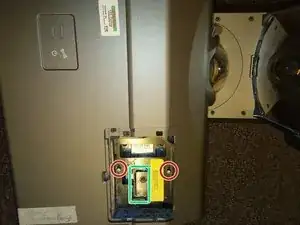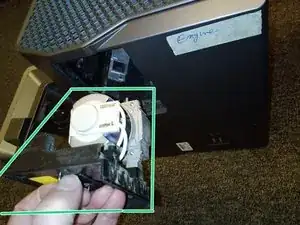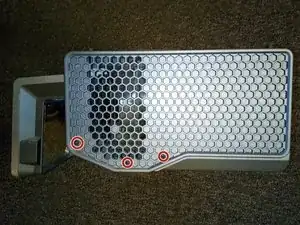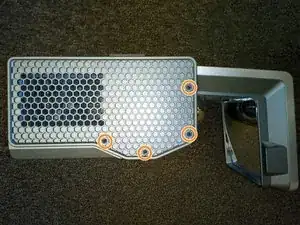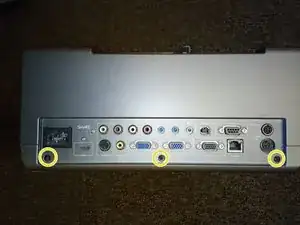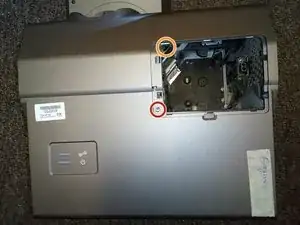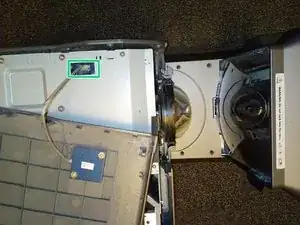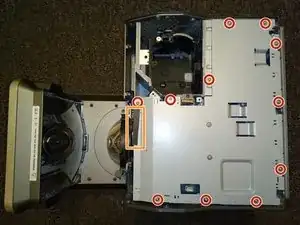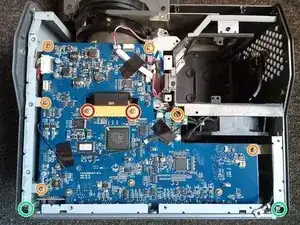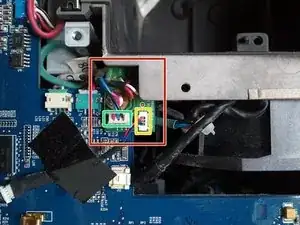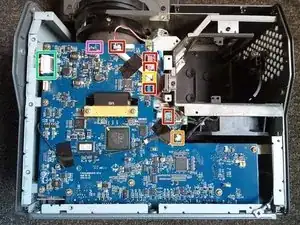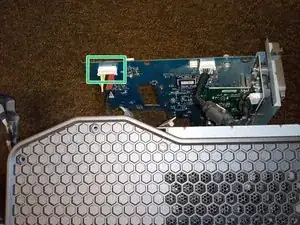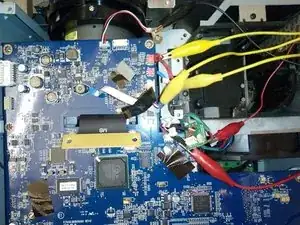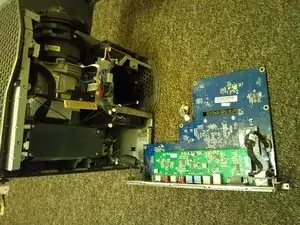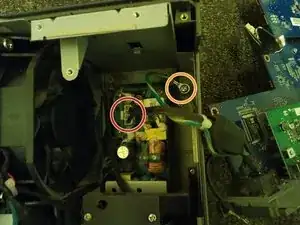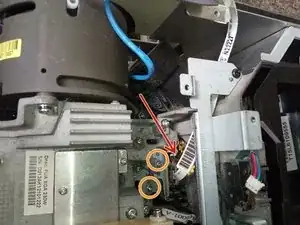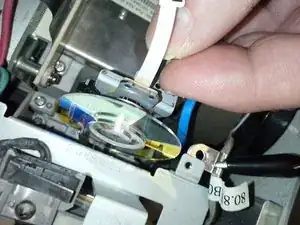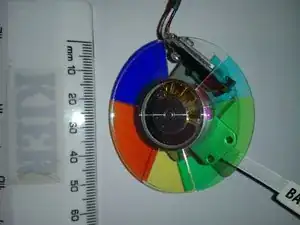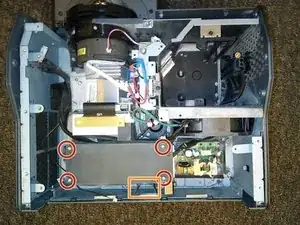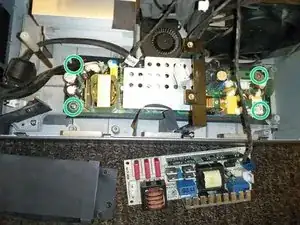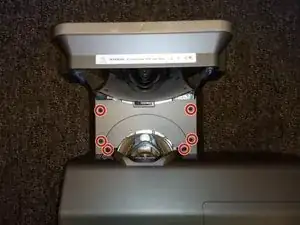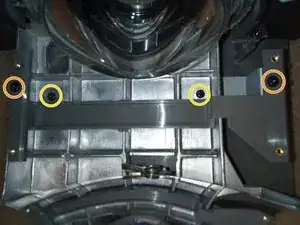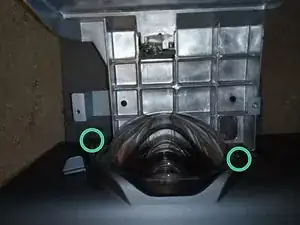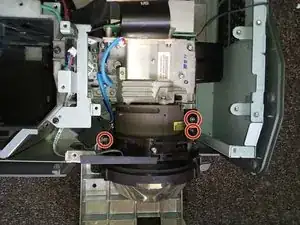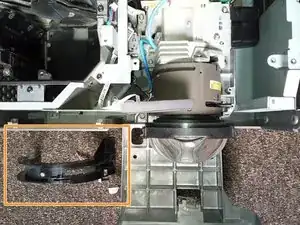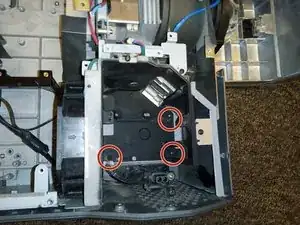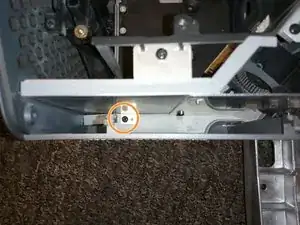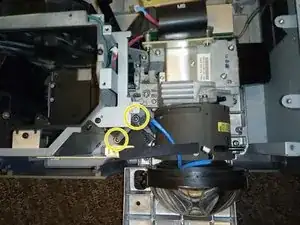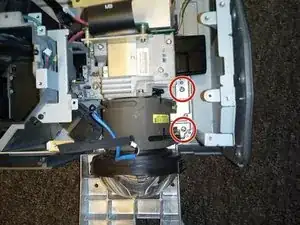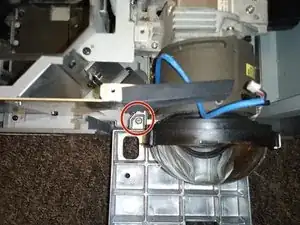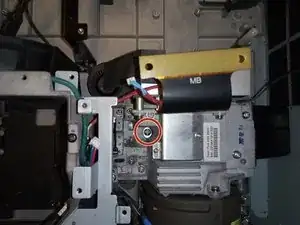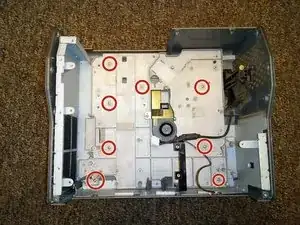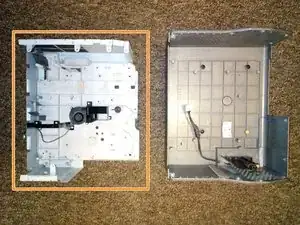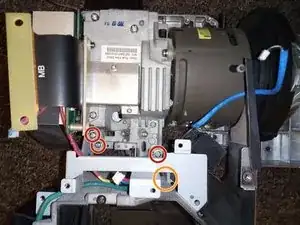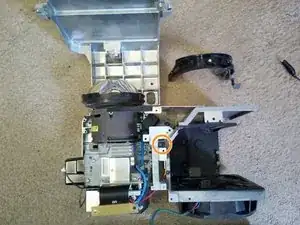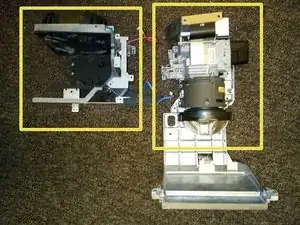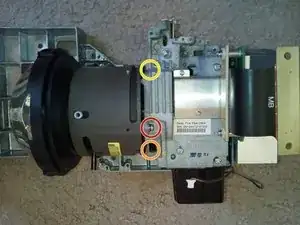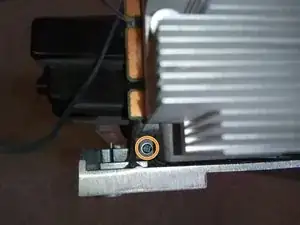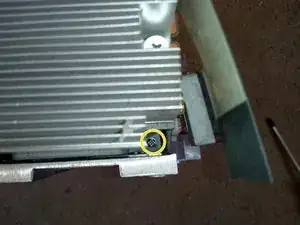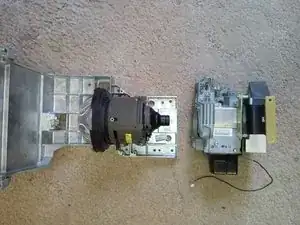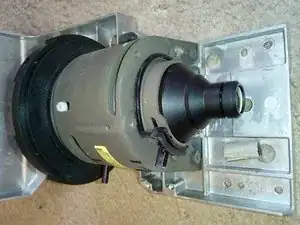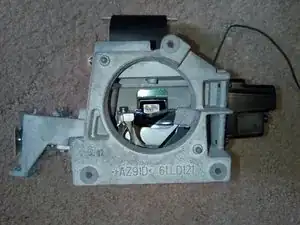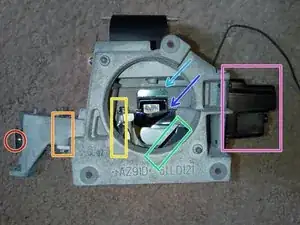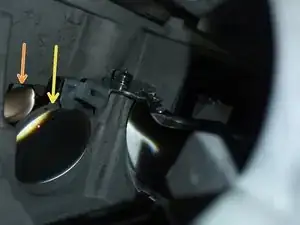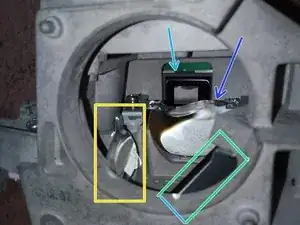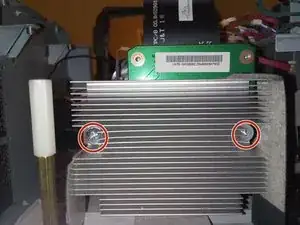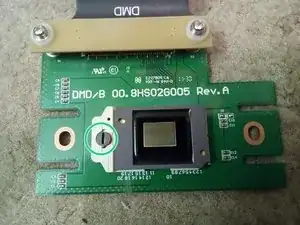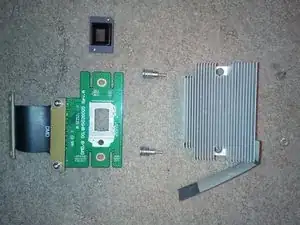Einleitung
The Smart UF75 projector shines light through a spinning colour wheel onto a Digital Micromirror Device (DMD) with 1024*768 small mirrors that move to switch each pixel on or off. The light is then focused and reflected off a curved mirror to create the ultra short throw.
The guide shows the separation of the core components of the projector.
The guide includes dismantling the important optical parts that were probably originally assembled in a clean room. Do not do this if you are intending to use the projector afterwards.
Werkzeuge
-
-
Use a flat screwdriver or coin to remove the flap covering the bulb module
-
Loosen these 2 Philips #2 screws. These screws should stay captive within the bulb module.
-
Lift this handle and pull out the bulb module.
-
-
-
Remove these 3 black 5mm Philips #2 screws from the right side panel.
-
Remove these 4 black 5mm Philips #2 screws from the left side panel.
-
Remove these 3 black 5mm Philips #2 screws from the rear panel.
-
-
-
Remove this 7mm Philips #2 screw under the bulb cover.
-
Remove the 7mm Philips #2 screw deep in this hole. A magnetic screwdriver essential for removing and replacing this inaccessible screw.
-
The lid can now be removed by gently prising it off starting at the hole for the bulb.
-
Unplug this cable then put the projector lid to one side.
-
-
-
Remove these 11 silver 5mm Philips #2 screws from the metal cover.
-
Unpeel this black card that is stuck to the metal cover.
-
Lift off the metal cover to reveal the main circuit board
-
-
-
Remove these 2 silver 8mm Philips #1 screws and their white plastic washers then unplug the ribbon cable. This plug will drop through the hole in the board when you lift off the board.
-
Remove these 6 silver 8mm Philips #2 screws from the main circuit board.
-
Remove these 2 silver 6mm Philips #2 screws that attach the board of plugs at the back of the projector.
-
-
-
Projectors built in 2010 have a small extra circuit board here. You can skip this step if you have a newer projector without this extra circuit board.
-
Unplug this wire from the small circuit board. Peel back the two pieces of tape holding down the wire, leaving one end of each piece of tape attached to the board for the later re-assembly
-
Remove the other plug from this small circuit board. The small circuit board is now free to come away with the main circuit board.
-
-
-
Unplug these 5 plugs. These plugs are stiff but there are no clips or catches to release. I used a combination of pliers and miniature side cutters to grip the two edges of each plug and work it loose.
-
Remove this plug by pressing down the back of the plug to release the catch
-
Gently remove this thin ribbon cable by pulling back the plastic plug then pulling out the cable. Untape the ribbon cable from the board.
-
Later models have an extra wire here that needs to be unplugged.
-
Remove this larger plug by squeezing the two ends to release the clips. On later models, this plug is underneath the board, so you will need to release it while you are removing the circuit board
-
-
-
Remove the main circuit board by lifting the board from the back end where the external plugs are attached.
-
Unplug this mains plug.
-
Disconnect the earth lead by unscrewing this silver 5mm Philips #2 screw with its captive serrated washer.
-
-
-
To make a coloured image, the light shines through this spinning colour wheel then onto a Digital Micromirror Device (DMD) with 1024*768 small mirrors that move to switch each pixel on or off.
-
Remove these 2 silver 6mm Philips #1 screws to detach the colour wheel.
-
To remove the colour wheel you will need to cut a cable tie and move the wires to the side.
-
Then gently remove the delicate glass colour wheel.
-
-
-
Remove these 4 silver 6mm Philips #2 screws to release the top power supply.
-
Peel off this cardboard that is glued to the power supply cover.
-
Unplug the large plug at each end of the power supply and the smaller fan wire. You can now remove the top power supply.
-
Remove these 4 silver 8mm Philips #2 screws from the lower power supply and unplug the small wire. You can now remove the power supply and the card it is sitting on.
-
-
-
Remove these 6 black 5mm Philips #2 screws to release the two plastic covers on the front of the mirror area.
-
Remove these 2 black 5mm Philips #2 screws to release the plastic bar that supported the front cover.
-
Remove these 2 black 5mm Philips #2 screws to release the metal bar that attached the support for the front cover.
-
Remove these 2 black 5mm Philips #2 screws that are attaching the back mirror cover..
-
Gently bend the back mirror cover to release the remote control receiver from the metal mirror mounting that it is hooked into. Then pull the mirror cover right back to unhook the plastic clips from the main projector.
-
-
-
Remove these 3 silver 8mm Philips #2 screws to release bracket that holds the lens adjuster knob.
-
And remove the bracket
-
-
-
Remove these 3 black 8mm Philips #2 screws holding down the lamp case.
-
And remove this fourth black 8mm Philips #2 screw holding down the front of the lamp housing.
-
Remove these 2 silver 6mm Philips #2 screws holding down the bulb fan.
-
-
-
If you want to separate the base chassis from the case, remove these 8 silver 8mm Philips #2 screws to separate the inner casing from the outer casing.
-
Then pull out the base chassis unit.
-
-
-
Remove these 3 silver 8mm Philips #2 screws.
-
And remove this fourth screw buried deep down this hole. The fourth screw is easiest to see in the second picture.
-
You can now separate the lamp housing from the rest of the optical system.
-
-
-
Remove 3 silver 12mm Philips #2 screws joining the DMD optical section to the front lens. The three screws cannot be seen in one picture, so three pictures are attached.
-
The top screw is visible as you look down on the unit.
-
The left hand screw is seen as you look along the left hand underside of the DMD heat sink
-
The right hand screw is visible as you look along the right hand underside of the DMD heat sink.
-
-
-
The first picture shows the front lens separated from the DMD optical section.
-
The second picture is a close up of the small lens at the back of the front lens section.
-
The third picture is a first look at the amazingly complicated DMD optical section. The next step takes a look inside this unit.
-
-
-
The light comes in from the colour wheel through a very small hole here.
-
It goes through a small lens here.
-
Then it goes through this lens
-
to get reflected off this mirror
-
and through this strange half lens onto the DMD chip at the back.
-
The DMD chip reflects selected pixels forwards to the front lens section.
-
The black box on the side is just another cooling fan.
-
-
-
Remove these 2 Philips #2 screws holding the DMD heatsink.
-
Pull back the heatsink then remove the DMD module
-
To remove the DMD chip, turn this screw half a turn anticlockwise.
-
5 Kommentare
Thanks so much! Just cracking the shell on this thing was hard enough its nice to have a teardown like this!
Thank you, Shane. It is nice to know the guide is appreciated. I wrote the guide when I was quoted £800 to repair one of our school projectors. Instead of paying I started buying second hand projectors, so I had nothing to lose from cannibalising the broken ones. Writing a guide helped me record the details to ensure I could put them back together!
With practice it gets easier to remove the case. They are quite strong. After removing ALL the screws I just pull hard at the opening for the bulb and I have not yet broken a case. Just remember to also remove the two screws hidden under the bulb cover.
David
David42 -
Many thanks for this, this guide is pretty helpful, however I need to replace or repair the mirror on it as whatever makes it reflective as rubbed off, any help is much appreciated.
simonc75 -
